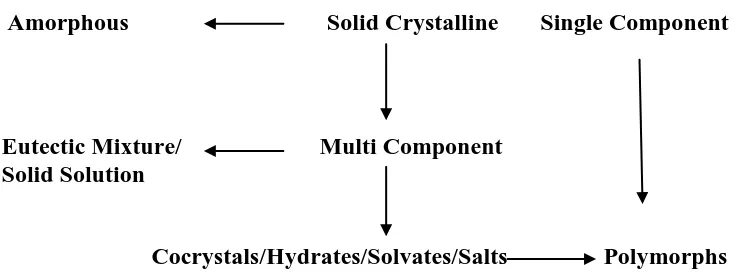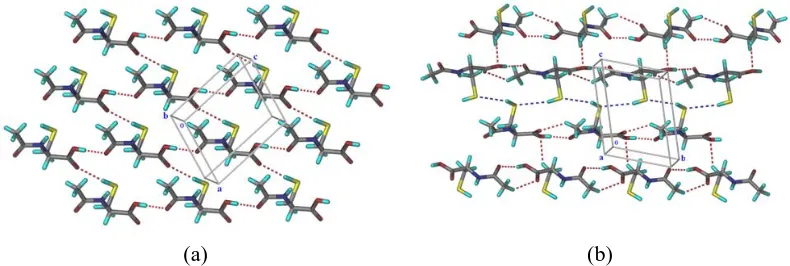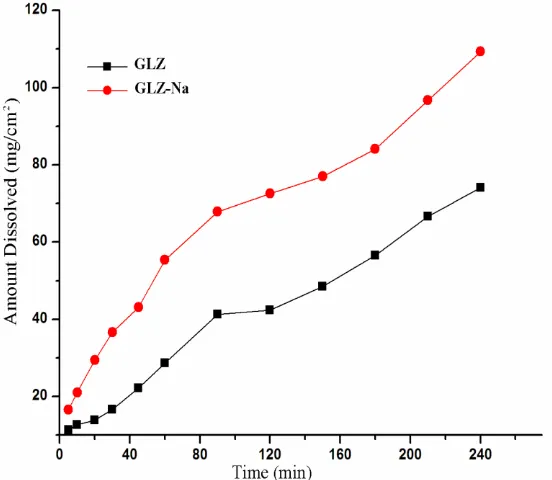xi | P a g e
Synopsis
This thesis entitled “Polymorphism and Solubility of Selected Active Pharmaceutical Ingredients”consists of seven chapters.
CHAPTER ONE
Introduction
Chemistry is an evolving subject and it is traditionally divided into four
categories as organic, inorganic, physical and analytical chemistry. A new classification in the modern era is the (supramolecular) solid state chemistry which is different from the molecular chemistry (liquids and gases). It has now reached the immense importance in the level of identification, separation and characterization of different crystalline forms of the same molecule or of aggregates of molecules with other molecules due to the difference in their physical and chemical properties. Physical properties are an intrinsic part of solid state chemistry since the broad area of structure-property relationship needs the identification of new solid crystalline forms such as polymorphs, solvates/hydrates, salts and cocrystals (Figure 1) and their characterization to understand their properties to control their activity. The importance of identifying these crystalline materials is to investigate their physico-chemical issues of active pharmaceutical ingredients (APIs) and address the solubility, stability and hydration problems using the crystal engineering approach. Crystal engineering of APIs through cocrystallization has gained an immense interest among the academicians, pharmaceutical scientists and US-FDA regulating as means of optimizing the physical properties and/or stability of solid dosage forms.
xii | P a g e in 2D or 3D. The term Pharmaceutical Cocrystal can be defined as “the crystalline complex of two or more neutral molecules is constituted including API, bonding together in the crystal lattice through non-covalent interactions such as hydrogen bonding”. Polymorphism and Cocrystallization has great importance in pharmaceutical industry, dyes and pigment, agrochemicals, explosive materials etc. due to its ability to alter the melting point, color, compressibility, filterability, stability, solubility etc. of the challenging solid materials. Salt formation is an acid base reaction and a compound having an acidic or basic group can crystallize in salt preparation in solution crystallizations. The traditional approach of salt formulation to improve drug solubility is unsuccessful with the molecules that lack of ionisable functional groups, have sensitive moieties that are prone to decomposition/ racemisation and/or are not sufficiently acidic /basic to enable salt formation.
Amorphous Solid Crystalline Single Component
Eutectic Mixture/ Multi Component Solid Solution
Cocrystals/Hydrates/Solvates/Salts Polymorphs
Figure 1 Various solid forms based on structure and composition variations.
xiii | P a g e soluble drugs in organisms may result in crystallization and acute toxicity. There is need to balance between solubility and dosage form of a drug. Overall, poor solubility of drug candidates has been identified as the main cause of numerous drug development failures at the final stages of formulations. We addressed these issues in some of the active compounds by correlating the differences in conformation, changes in functional groups in polymorphs and this study provides a guide in drug delivery for solubility optimization. In this thesis, we have chosen few drugs or biologically active compounds to study their polymorphic behaviours and cocrystal/salt formation using high throughput screening and highlighted their solubility and stability differences with respect to the structure modifications such as cocrystals and salt formation.
CHAPTER TWO
Polymorphism in Cardiosulfa and Its Analogs
xiv | P a g e polymorphs of molecule 5 contain the N−H···O catemer C(4) chain, whereas the sulfonamide N−H···O dimer synthon R22(8) was observed in polymorphs of 6. Differences in the strong and weak hydrogen bond motifs were correlated with the substituent groups and the solubility and dissolution rates with the conformation in the crystal structure of 1-6 (Figure 2). Higher solubility compounds, such as 2 (10.5 mg/mL) and 5 (4.4 mg/mL), adopt a twisted confirmation whereas less soluble 1 (0.9 mg/mL) is nearly planar. This study provides practical guides for functional group modification of drug lead compounds for solubility optimization.
N
N H
S O
R1
R2 R3 O
Molecule 1: R1 = NO2, R2 = H, R3 = CF3
Molecule 2: R1 = H, R2 = H, R3 = CF3
Molecule 3: R1 = CF3, R2 = H, R3 = H
Molecule 4: R1 = NO2, R2 = H, R3 = H
Molecule 5: R1 = H, R2 = CF3, R3 = H
Molecule 6: R1 = H, R2 = H, R3 = H
Scheme 1 Molecular structures of Cardiosulfa and its analogs.
(a) (b)
xv | P a g e CHAPTER THREE
Structure-property Comparison of Neutral and Zwitterionic Polymorphs Several amphoteric model compounds and drugs, such as isomers of aminobenzoic acids (ortho, meta, and para), N-aryl-2-amino-nicotinic acids (three isomers), drugs such as aminosalicylic acids (meta and para), clonixin, and niflumic acid were selected to obtain their reported zwitterionic and neutral polymorphs (Scheme 2) with the objective to correlate their X-ray crystal structures with solubility and dissolution rate, and stability. We were successful in crystallizing neutral and ionic polymorphs for 2- and 3-aminobenzoic acid (ABA), 2-(p-tolylamino)nicotinic acid (TNA), and clonixin (CLX), as well as 4- and 5-aminosalicylic acid (4-ASA as neutral and 5-ASA in ionic form). The neutral and zwitterionic crystalline polymorphs were differentiated by their distinctive powder XRD, FT-IR, Raman and ss-NMR spectroscopy, and further quantified by Hirshfeld surface analysis. Phase transitions were monitored by DSC and VT-PXRD. The difference in solubility and dissolution rates of the neutral and zwitterionic polymorphs were correlated with their hydrogen bonding, see Figure 3a-c, (O–H···O, O–H···N and N+–H···O–). The faster dissolution rates of the ionic forms were ascribed to stronger, attractive interactions between the solvent molecules and the zwitterionic functional groups (Figure 3d). Even as there is no general strategy yet to crystallize ionic polymorphs of amphoteric molecules, the present study shows the advantages of zwitterionic forms for solubility enhancement.
NH3 COO COO NH3 N H N COOH C H3 NH2 COOH N H N COOH CH3 Cl COOH NH2 N H N COO C H3 H N H N COO CH3 Cl H + +
2-ABA, ionic 1 3-ABA, ionic 3
2-ABA, neutral 2 3-ABA, neutral 2 TNA, neutral 2 CLX, neutral 3
+ +
CLX, ionic 1 TNA, ionic 1
xvi | P a g e
(a) (b) (c)
(d)
Figure 3 Clonixin polymorphs. (a) Strong acid–pyridine O–H···N synthon in neutral form I (a), acid dimer O–H···O R22(8) motif in neutral form III (b), acid– pyridine ionic N+–H···O–H bond in zwitterionic form II (c), Dissolution profile of CLX polymorphs in 60% EtOH–water.
CHAPTER FOUR
Conformational Polymorphs of N-Acetyl-L-cysteine
xvii | P a g e form II has only N–H···S interaction (Figure 4). The conformational polymorphs of NAC were compared by Hirshfeld surface analysis (dnorm) and XPac methods, and spectroscopically characterized by FT-IR and Raman. The bulk phases were distinguished by their 13C ss-NMR and powder X-ray diffraction line patterns. The two polymorphs are enantiotropically related (form I has higher melting temperature and lower enthalpy of fusion). However, no phase transition was observed in DSC. The metastable form II converted to stable form I in solid-state grinding, slurry medium, and storage in ambient conditions for 3 months.
(a) (b)
Figure 4 NAC polymorphs (a) 2D network of S−H···O and O−H···O hydrogen bonds in form I. (b) C−H···O hydrogen bonds (red dots) and S−H···S short contacts (blue dots) in form II.
CHAPTER FIVE
Pharmaceutical Cocrystals of Voriconazole
xviii | P a g e notable result from a crystal engineering viewpoint is that the supramolecular synthon between the basic drug and the acidic coformer undergoes a switch based on the pKa of the acid. The solubility of Voriconazole-nitrate salt is 10 times
higher soluble than the API in acidic medium (0.1 N HCl), see Figure 5.
F F
N N N
N N
F CH3
O H
NH2 COOH
OH
COOH COOH
NO2 HNO3
R S
Voriconazole, VZL Nitric acid PABA PHBA 3-NBA 1
Scheme 3 Voriconazole and its successful coformers in cocrystallization method.
xix | P a g e CHAPTER SIX
Pharmaceutical Salts of Active Compounds
Almost half of the drugs are marketed as salts and reported as they have improved the performance of drug product in clinical usage. This is well established solid formulation in pharmaceutical field in respect to improving drug properties of BCS class II using cocrystallization technique. Gliclazide (GLZ), Clonixin (CLX) and Clofibric acid (CLF) are the low aqueous soluble drugs selected for salt screening experiments in an attempt to improve their solubility (Scheme 4).
O
Cl
COOH
S N H O
O NH
N O
N H
N Cl
COOH
Giclazide Clonixin Clofibric acid
Scheme 4 Molecular structures of selected APIs for salt screen.
xx | P a g e Figure 6.1Dissolution profile of GLZ and GLZ-Na in 50% EtOH-water mixture
at 37 ºC.
xxi | P a g e mg/cm2/min) than the clonixin drug (1.9 mg/mL, 0.14 mg/cm2/min). Two salts are found to more soluble than the stable zwitterionic form (2.0 mg/mL, 0.20 mg/cm2/min) of CLX (Fig 6.3).
(a) (b)
Figure 6.2 (a) N–H···O and N–H···N interaction in CLX-PIP (b) N–H···O and C–H···N interactions in CLX-CYT.
Figure 6.3 Dissolution profiles of CLX and CLX-PIP and CLX-CYT salts in 60% EtOH-water mixture at 37 ºC.
xxii | P a g e angiogenesis and induction of apoptosis (fibrate; fenofibrate). GRAS molecules as the coformers such as Piperazine, Cytosine etc. were used to obtain new salt solid forms of CLF using the solution crystallization techniques. Piperazinium-clofibrate PIP) salt and Cytosinium-Piperazinium-clofibrate-cytosine monohydrate (CLF-CYT) confirmed by only single crystal XRD and refined in P21/n and C2 space groups respectively. The CLF molecule is interacting with piperazine molecule via two strong hydrogen bond N+–H···O– (1.68Å, 176º, 1.72 Å, 163º) and one N+–H···O– weak hydrogen bonds (2.53Å, 119º) in CLF-PIP (Figure 6.4a). In case of CLF-CYT, two neutral cytosine molecules are interacting via two point N– H···O synthon (1.84 Å, 169º) where as the ionic cytosine were connected by two point ionic synthon N+–H···O– (1.81Å, 174º) interactions. The neutral cytosine is connected directly to two different clofibric acid molecules by only N1–H1···O2 (1.83Å, 174º) and N3–H3B···O3 (2.01Å, 159º) interactions. The weak hydrogen bonds O6–H6B···O3 (1.84Å, 161º) and O6–H6C···O2 (2.12Å, 136º) is connecting the water molecules with CLF and the N4–H4B···O6 (1.93Å, 160º) interactions is bound by cytosinium ions. CLF-PIP salt is easily reproducible compared to cytosinium salt and it exhibits the highest solubility of 18.3 mg/mL and two times improvements in dissolution rate of 0.98 mg/cm2/min with respect to the solubility 2.7 mg/mL and dissolution rate 0.42 mg/cm2/min of CLF drug in 20% EtOH-water mixtures (Figure 6.5).
(a) (b)
xxiii | P a g e Figure 6.5 Dissolution profiles of CLF and CLF-PIP salts in 20% EtOH-water mixture at 37 ºC.
CHAPTER SEVEN
Conclusions and Future Prospects
xxiv | P a g e sulfonamide molecules. Planar sulfonamide molecules pack more efficiently in the crystal lattice and hence are less soluble; molecules with a bent molecular conformation were found to have higher solubility. Finally, Cardiosulfa appears to be the best candidate in the series studied because despite its lower solubility there is no evidence of polymorphs. In chapter 3, the structural-cum-solubility study of neutral and zwitterionic polymorphs of selected four ampholytes provides methods for their preparation and a comparison of solubility–stability characteristics. Generally solubility and stability are inversely related for drug polymorphs. We show that the twin characteristics of high solubility and good stability may be jointly optimized in the same zwitterionic polymorph for amphoteric drugs. The selective crystallization of zwitterionic forms could be possible through crystallization promoter additives such as ionic liquids, polymer-induced heteronucleation, and seeding with ionic structural mimics. In chapter 4, the stability of form II is compared with the weak interactions to understand the hydrogen bonding-crystal stability relationship.







